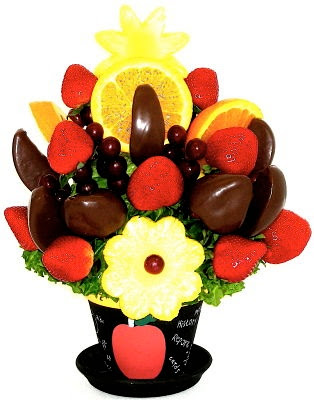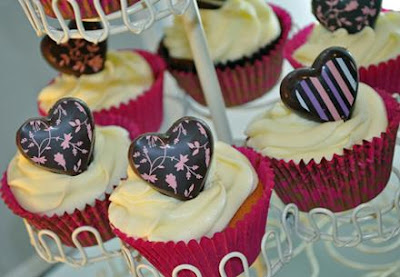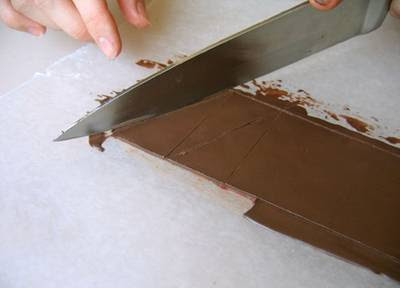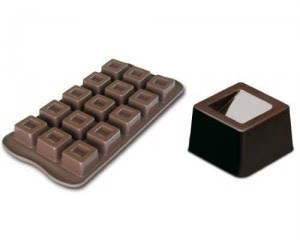The History of Chocolate of the world's most favorite foods is filled with intrigue, political maneuvering, and innovation. The path from a fermented alcoholic drink to a candy bar at the corner store has been marked by numerous twists and turns, and even today, the world of
Chocolate is filled with secrets, ethical controversy, and constant new developments.
Chocolate is a multibillion dollar industry, and it should come as no surprise to learn that
The History of Chocolate is closely intertwined with the history of colonial expansion, the Industrial Revolution, and even wars.
Most people are aware that
The History of Chocolate begins in South and Central America, where Native Americans have been using the beans of the Theobroma
Cacao, or
cacao plant, for centuries. The first evidence of the use of
Chocolate for culinary purposes dates to around 1400 BCE, when the Mayans apparently fermented the pulp which surrounds
cacao beans to create an alcoholic beverage. By the first century CE, the Mayans were using the beans, fermenting them and then grinding them with ingredients such as cornmeal,
Vanilla beans, and chilies on a metate to create a spicy, bitter paste which could be whisked with water to create a drink known as xocolatl.
Mayan xocolatl would not be to the taste of most modern consumers. The Mayans exclusively drank their
Chocolate, blending their ground
cacao beans with water and then pouring the drink back and forth between two cups to develop a densely foamy drink.
Chocolate was so revered in Mayan culture that it was used in religious ceremonies. Most Mayans had a
cacao tree growing in their back yards, making chocolate accessible to all members of Mayan society. The wealthy, of course, had special drinking dishes for
Chocolate, complete with elaborate decorations which included depictions of growing, harvesting, and preparing
cacao beans.
The Mayans established a vibrant trade in
Chocolate, exchanging the beans with other Native American peoples who lived in regions where
cacao trees could not be cultivated. When Aztec culture began to rise in the 12th century, the Aztecs picked up the habit of drinking
Chocolate, and it became a drink for the Aztec elite, the only ones who could afford the treasured beans. In fact,
cacao beans were even used as currency by the Aztecs, who would trade the beans for everything from fruit to slaves.
After Columbus traveled to the New World in 1492, he returned with a ship laden with a variety of trade goods, including some
cacao beans, describing
Chocolate as a “divine drink which builds up resistance and fights fatigue.” The Spanish Court, however, failed to realize the value of
Chocolate until another conquistador, Herman Cortez, conquered the Aztec empire and established
cacao plantations, shipping the beans back to Spain. In Spain,
Chocolate became a drink of the elite and high-ranking church officials, and Spain held a monopoly on
Chocolate for over 100 years.
The Spanish were dissatisfied with
Chocolate as it was prepared in South America. They found the drink too bitter, and they disliked the foamy texture. As a result, the Spanish came up with the brilliant idea of adding sugar and cinnamon to their
Chocolate. They also developed a special utensil, the molinillo, for stirring
Chocolate. Spanish explorers expanded their holdings in South America specifically for the purpose of maintaining the
Chocolate monopoly, establishing large plantations for
cacao cultivation and using slave labor to produce the crop.
Chocolate remained Spain's little secret for quite some time. Other Europeans were so unaware of the value of
Chocolate that when Spanish ships were attacked by English pirates, the pirates routinely destroyed cargoes of
cacao beans, thinking that they were worthless. While Europeans certainly realized that Spain had stumbled across a number of treasures in the New World, it wasn't until the 1600s that the craze for
Chocolate hit the rest of Europe.
With an increased desire for
Chocolate in places like France, England, and the Netherlands came an increased demand for
Chocolate production. Numerous countries colonized regions which would be suitable for
cacao production, and established large plantations of
cacao, sugar, and other South American crops which could be cultivated by slaves and sold at an immense profit. Even with increased production,
Chocolate was still extremely expensive, and its consumption was restricted primarily to the elite, who consumed it in trendy
Chocolate houses.
As
Chocolate spread across Europe, various countries created their own formulations, adding ingredients like milk to make the drink more palatable. However,
Chocolate remained firmly in liquid form, served in exotic and elaborate
Chocolate pots which paired with beautiful china customized for the service of
Chocolate.
The History of Chocolate took a dramatic turn in the Industrial Revolution, when the development of mass production techniques made the once-elite beverage accessible to a much larger segment of society. In 1828, inventors developed a technique for pressing
cacao beans to separate the cocoa solids and cocoa butter, using a hydraulic press, and this changed the nature of
Chocolate production quite radically. Prior to the development of the hydraulic press,
Chocolate was sold in the form of a crumbly, very high-fat mixture which was hard to use and digest. With the development of the press, consumers could purchase cocoa powder, an inexpensive, easily handled alternative.
However,
Chocolate was consumed primarily in liquid form until the 1800s, because no one had succeeded in making an edible form of solid
Chocolate, and
Chocolate cookies were not yet wildly popular. Eating
Chocolate was introduced in the 1830s, and it would have been a grainy, bitter affair until the 1870s, when
Chocolate manufacturers finally came up with conching.
When
Chocolate is conched, it is ground for hours or days to create a smooth product with a very uniform, creamy texture. Conching allowed the market for eating
Chocolate to explode, as consumers — for the first time — could eat quality
Chocolate bars. It also allowed
Chocolate companies to create a variety of
Chocolate coatings and dips, enabling the production of candy bars coated in
Chocolate, a perennial favorite.
Industrialization of the
Chocolate industry also brought attention to its dark side, however. Many
Chocolate companies were accused of using child and slave labor in their plantations and factories, and the growing labor movement began to agitate for reform both at home and abroad. In response to public concerns, chocolatiers also began to speak out about the working conditions involved in
Chocolate production, with some companies like Cadbury's pledging to eliminate ethically unsound labor from the production of
Chocolate as early as 1910.
In the late 1800s, numerous manufacturers marketed their eating
Chocolate as a healthy addition to the diet, targeting mothers and children especially. All sorts of claims were made about
Chocolate and human health, with
Chocolate packaging including detailed descriptions of all the benefits
Chocolate conferred. The idea of
Chocolate as a health food was so firmly entrenched that manufacturers sold “breakfast
Chocolate,” eating
Chocolate designed to be consumed at breakfast, and
Chocolate was considered a vital part of rations for soldiers during the Civil War in the United States.
The History of Chocolate and the military continues to this day. Many major military conflicts have spurred unique developments in the world of
Chocolate, in an attempt to produce
Chocolate which could be integrated into wartime rations. In the Second World War, for example, Mars Incorporated introduced M&Ms to American GIs, and in the First Gulf War, confectioners vied to produce a
Chocolate which wouldn't melt in the heat of the Middle East.
In addition to World Wars, the 20th century also saw an explosion of confectionery wars. Mars and Hershey in particular have battled for
Chocolate supremacy since the 1940s in the United States, with counterparts like Rowantree and Cadbury's duking it out overseas. Industrial espionage was such a huge problem in the
Chocolate industry in the 1960s that it was parodied in Charlie and the
Chocolate Factory. In the 1980s, with the breakdown of the Soviet Union, major
Chocolate producers saw further possibilities for expansion, engaging in extravagant advertising campaigns targeted at
Chocolate-starved residents of Asia and Eastern Europe.
Today, two thirds of the world's
Chocolate comes from West Africa. The
Chocolate industry continues to struggle with ethical issues like child labor, fair working conditions, and the environment. Several
Chocolate companies have even been accused of manipulating national governments in the quest for a stable supply of
Chocolate, much like United Fruit did in South America with bananas. In response, products like Certified Fair Trade
Chocolate have arisen, and a number of
Chocolate companies have corporate responsibility programs which are designed to allay consumer fears about the source of their
Chocolates.
Consumers have also been struck with fear by a number of
cacao disease scares, which have periodically threatened the world's supply of
Chocolate. Diseases which affect
cacao plants tend to spread rapidly, decimating
Chocolate crops across an entire region. In addition to potentially affecting overall supplies of
Chocolate, such diseases could have a serious impact on the flavors which consumers have grown to know and love.
Chocolate companies each produce their own unique blends for the products they make, and small deviations in these blends are often very noticeable. For this reason, several producers have large experimental plantations where they work on breeding disease-resistant plants and developing new strains of
cacao beans.
Candy producers continue to be extremely careful about revealing their production secrets. Many
Chocolate factories are closed to the public, and access to the factory floor is tightly controlled, with even executives admitting that they don't know precisely how their products are made. Innovation in the field of
Chocolate continues as well, with candy producers big and small putting out a plethora of new
Chocolate products every year, ranging from gourmet
Truffles to new candy bars. Competition between major manufacturers is fierce, with companies vying to produce the next big
Chocolate sensation, much to the delight of many consumers.
The opening of the 21st century has also revealed new horizons in
The History of Chocolate, with gourmet chocolatiers creating unique and distinctive
Chocolate blends.
Chocolate aficionados have also been able to choose from a wide assortment of regionally sourced
Chocolates focusing on rare and unusual beans. A number of smaller
Chocolate companies also specialize in regional delicacies which have become cult favorites.





















































